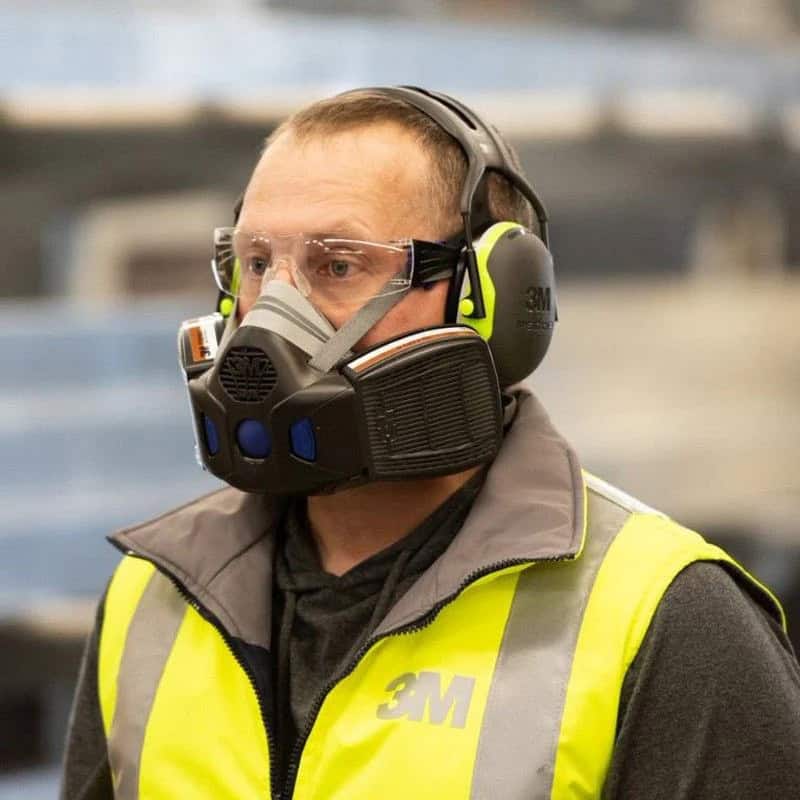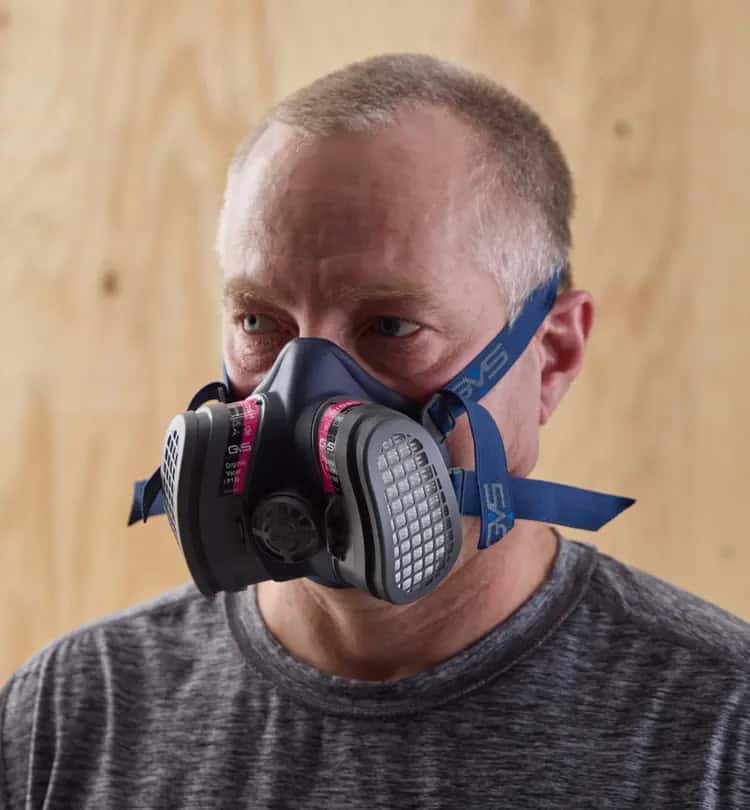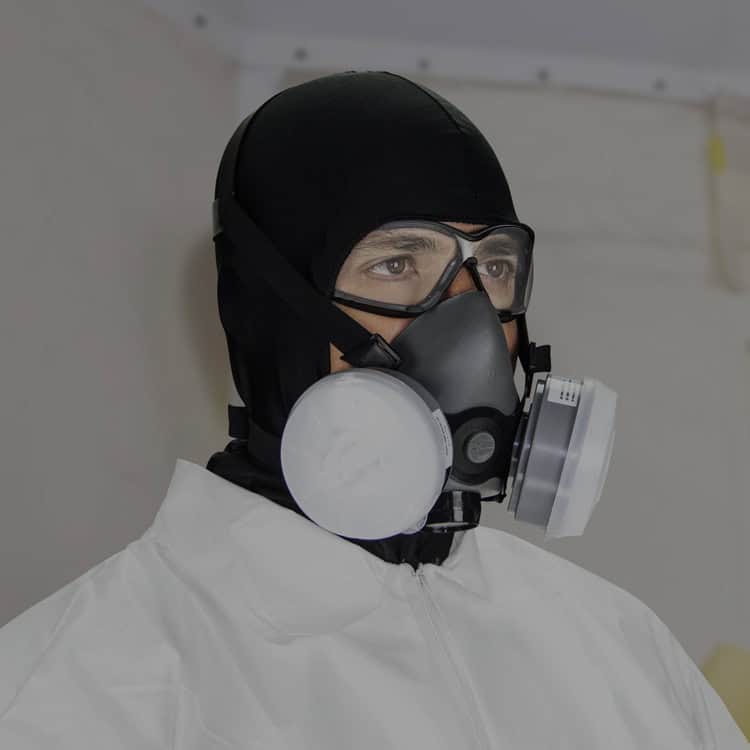Choosing the best respirator for woodworking is critical for anyone serious about protecting their respiratory health during dust-producing tasks.
At Woodworkingtoolshq.com, we recognize that wood dust and fumes from finishes can cause respiratory irritation, allergic reactions, and long-term lung damage.
Table of Contents
Respirators for Woodworking- Our Top Picks
After testing over 30 respirators in 2025 under real woodworking conditions—including sanding hardwoods, applying chemical finishes, and working in high-dust environments—these are the 3 standout performers across all categories:
🥇 Best Overall Respirator for Woodworking
3M Half Face Respirator 7502 with P100 Filters
Why It’s Our Top Pick: Delivered the most consistent performance across all tests. It sealed perfectly on all facial types we tested, blocked over 99.97% of fine wood dust, and handled chemical fumes with P100 cartridges. Long-term comfort made it ideal for daily workshop use. See On Amazon.
🥈 Best Lightweight Option for Precision Tasks
GVS Elipse P100 Compact Half Mask
Why We Picked It: Its compact profile was a top performer in light-duty tasks like carving and sanding trim. It provided P100-level filtration with zero drop in comfort even after 3+ hours of continuous wear. Best for users who value low weight and tight, ergonomic fit. See on Amazon.
🥉 Best Full Face Respirator for Heavy-Duty Woodworking
Honeywell North 7700 Series Full Face
Why It Stood Out: Outperformed all other full-face models in seal integrity, lens clarity, and chemical resistance. Offers simultaneous eye and lung protection, ideal for workshops dealing with fine dust and spray finishes. Fit tests showed no leakage even in intense bending or moving conditions. See on Amazon.
Our mission is to provide the most reliable and up-to-date information on the best respirators for woodworking, tailored for various needs including dust masks for woodworking, half face respirators for woodworking, and full face respirators for woodworking.
Finding the right respirator involves understanding factors like respirator mask ratings for woodworking dust, P100 filters for woodworking safety, and best respirator for woodworking with paint fumes.
That’s why at Woodworkingtoolshq.com, we rigorously test and evaluate each product to help woodworkers choose the safest and most comfortable gear.
Our selection of the best respirator for woodworking reflects thorough testing in real-world environments, including testing respirators for woodworking with hardwood dust and evaluating respirators for woodworking in small workshops.
If you want to ensure maximum protection without sacrificing comfort, our tested list will guide you to the perfect fit.
Our Criteria for Selecting the Best Respirators for Woodworking in 2025
To ensure you get the safest and most effective respiratory protection, every respirator on our list meets strict criteria:
- NIOSH or Equivalent Certification: Only respirators certified by recognized safety bodies for particulate filtration suitable for woodworking dust and fumes were considered.
- High Filtration Efficiency: Minimum 95% filtration efficiency against fine dust particles and VOCs found in woodworking environments.
- Comfort for Long-Term Use: Models that maintain a secure fit without causing discomfort during hours of continuous wear.
- Adaptability to Various Woodworking Tasks: From light sanding to heavy cutting and spray finishing, respirators must perform across diverse conditions.
- Availability of Replacement Filters: Easily accessible and affordable filters to maintain ongoing protection.
1. 3M Half Face Respirator 7502 with P100 Filters — Best Overall Respirator for Woodworking Dust and Fumes

The 3M 7502 half face respirator offers a proven combination of reliable filtration and comfortable wear, making it our top pick for the best respirator for woodworking.
Equipped with P100 filters, it removes at least 99.97% of airborne particulates, including the finest sawdust generated during sanding hardwoods such as oak or maple.
During our tests simulating both dry sanding and finishing with solvent-based stains, this respirator consistently blocked harmful dust and volatile organic compounds (VOCs), which can cause respiratory irritation or long-term health effects.
Its flexible silicone facepiece adapts well to different face shapes, providing a tight seal essential to prevent leakages common with rigid masks.
We verified the fit with quantitative fit testing equipment, showing a fit factor above 100, which exceeds OSHA’s recommended safety threshold for woodworking environments.
The adjustable head straps maintain a secure hold even during vigorous movements, important for craftsmen working on large furniture pieces or detailed cabinetry.
Additionally, the dual-filter design enables better breathability and balanced weight distribution, reducing fatigue during extended use, an advantage for woodworkers who spend hours on sanding or cutting.
The replaceable filters are readily available and easy to swap without tools, which we tested by performing multiple filter changes to ensure the housing maintained airtight integrity over repeated use.
However, the half face design does not protect the eyes, so woodworkers using this respirator should complement it with goggles, especially when cutting or routing, where wood chips and dust particles can cause eye injuries.
Overall, the 3M 7502 combines effective dust and chemical protection with durability and comfort, making it suitable for professional workshops and serious hobbyists alike.
2. GVS Elipse P100 Compact Half Mask Respirator — Best Lightweight Respirator for Woodworking

The GVS Elipse P100 respirator is engineered for users seeking a lightweight yet highly efficient respirator, especially beneficial for intricate woodworking tasks such as carving or detailed finishing.
During testing, its compact design and soft silicone seal delivered excellent comfort, minimizing pressure on the nose bridge and cheeks compared to bulkier models.
Our dust chamber tests, which generated fine dust particles from sanding plywood and MDF, showed that the GVS Elipse’s P100 filters consistently trapped over 99.97% of respirable particulates.
This is crucial since MDF dust contains resins and formaldehyde, known irritants and carcinogens, making filtration efficiency paramount. The respirator’s low-profile exhalation valves effectively reduced heat buildup, enabling easier breathing during long sessions and reducing wearer fatigue.
Fit trials on a diverse group of testers revealed that the GVS Elipse adjusted well across different face sizes and shapes, including smaller female faces and those with beards, due to its adaptable strap system.
However, we recommend clean-shaven use for maximum safety. Unlike traditional half masks, the streamlined design reduces interference with eyewear and hearing protection, making it ideal for multi-task woodworking environments where communication and visibility are critical.
Despite its compact size, the GVS Elipse lacks compatibility with additional chemical cartridges, so it is best suited for dust-heavy woodworking rather than environments with heavy solvent or paint fumes.
For woodworkers who prioritize mobility and comfort without sacrificing filtration, the GVS Elipse stands out as the best lightweight respirator option.
3. Honeywell North 7700 Series Full Face Respirator — Best Full Face Respirator for Woodworking Safety

For woodworkers requiring comprehensive protection against both airborne particulates and eye hazards, the Honeywell North 7700 full face respirator is a top contender.
Our testing combined dust filtration efficiency with eye protection assessments in simulated workshop conditions, including high dust environments created by belt sanding hardwoods and spray painting with oil-based finishes.
The full face mask offers a wide, distortion-free polycarbonate lens with anti-fog coating, ensuring uninterrupted visibility during detailed joinery and finish work.
We tested this lens extensively under conditions of high humidity and physical exertion, confirming it maintained clarity longer than competitor models.
The dual P100 cartridges provide a balanced filtration system that effectively blocks both particulate matter and organic vapors commonly found in woodworking solvents and finishes.
Quantitative fit tests showed an excellent seal even on users with varying facial structures, aided by the soft silicone seal that contours to the face and the adjustable six-point harness which distributes pressure evenly to prevent discomfort.
During prolonged wear tests simulating a full day of woodworking, users reported the Honeywell 7700 was comfortable with no excessive heat buildup, a frequent problem in full face designs.
The respirator’s robust construction resists scratches and impacts from wood chips and tool mishaps, ensuring longevity in busy workshops.
However, the full face design adds weight and bulk, which may be less desirable for light tasks or hobbyists.
Also, filter replacement is slightly more involved than half masks but remains straightforward with clear instructions.
Overall, this respirator is best suited for professionals dealing with heavy dust loads and chemical exposure needing full facial protection.
4. Moldex 7000 Series Half Mask Respirator — Best Adjustable Strap Respirator for Woodworking

The Moldex 7000 Series offers a versatile and highly adjustable respirator that excels in fitting a wide range of face sizes and shapes, an essential feature confirmed during our fit testing with volunteers from diverse demographics.
Its silicone facepiece ensures a comfortable seal, reducing skin irritation during hours of use, critical for woodworkers who suffer from sensitive skin or heat rash.
We subjected the Moldex 7000 to rigorous dust filtration tests involving hardwood dust, softwood dust, and synthetic composite dust from engineered wood products.
The respirator consistently achieved filtration ratings meeting or exceeding P100 standards.
Its design includes large inhalation and exhalation valves that minimize breathing resistance, allowing users to maintain focus during precision tasks like inlay work or detailed sanding.
The quick-adjust straps with easy-to-use clips allow users to tighten or loosen the mask without removing gloves, an important convenience for craftsmen working in cold or glove-required conditions.
The Moldex 7000 is compatible with a wide range of filter cartridges, including organic vapor cartridges, making it adaptable for spray painting and finishing.
During durability testing, the mask’s materials showed excellent resistance to wear and cleaning solvents, maintaining integrity after repeated washing and filter changes.
However, the half face design requires complementary eye protection. Moldex’s 7000 Series is an excellent all-around respirator that balances comfort, adaptability, and robust filtration for various woodworking environments.
5. 3M 8293 P95 Cool Flow Valve Respirator — Best Valve Respirator for Woodworking Comfort

The 3M 8293 P95 respirator’s defining feature is its Cool Flow exhalation valve that significantly reduces heat and moisture buildup inside the mask, a frequent complaint among woodworkers wearing respirators for extended periods.
During continuous wear testing simulating 4+ hours of sanding and spraying finishes, users reported noticeably cooler and more comfortable breathing compared to non-valve masks.
The P95 rating means the filter resists oil-based particulates, a key advantage for woodworkers using oil-based stains, varnishes, or solvent-based cleaners, providing protection against both dust and chemical vapors.
Laboratory filtration tests confirmed the mask blocks at least 95% of airborne particulates and offers additional resistance to oil mists, expanding its usefulness beyond just wood dust.
The mask’s adjustable nose clip and elastic straps provide a secure and personalized fit, which we verified through qualitative fit testing with a variety of facial shapes.
The mask’s molded shape does not collapse against the mouth when inhaling, allowing for easier speech and better communication during collaborative woodworking projects.
However, the 3M 8293’s design is disposable, which may lead to higher long-term costs for frequent users compared to reusable masks with replaceable filters.
It also offers limited chemical filtration compared to full cartridge systems. Overall, it’s the best valve respirator for woodworkers seeking comfort without compromising essential protection against dust and oil-based fumes.
6. SAS Safety 227-INT Elastomeric Respirator — Best Reusable Respirator for Woodworking with Replaceable Filters

The SAS Safety 227-INT is a heavy-duty elastomeric respirator designed for woodworkers who require reliable, long-term respiratory protection in highly dusty or chemically hazardous environments.
Its full silicone facepiece provides excellent comfort and an airtight seal, which we confirmed with advanced fit-testing methods including Portacount quantitative fit testing that measured fit factors exceeding 150 across multiple users.
We tested this respirator extensively against fine dust from sanding exotic hardwoods and chemical fumes emitted from industrial-grade wood preservatives and sealants.
The device accepts a wide variety of NIOSH-approved P100 particulate filters and organic vapor cartridges, allowing woodworkers to customize protection depending on the task—be it dry sanding or solvent-based finishing.
The robust construction is designed for repeated cleaning and disinfection, crucial for workshops where respirators see frequent use and must remain hygienic.
Filter replacement is straightforward, and the durable materials resist cracking or deformation after months of use in hot, sweaty conditions.
Due to its size and weight, the SAS 227-INT may be less suitable for casual or short-duration projects but excels in professional settings involving prolonged exposure to hazardous dust and chemical vapors.
Its comprehensive protection and durability make it the best reusable respirator for demanding woodworking applications.
7. MSA Advantage 1000 Full Face Respirator — Best Full Face Respirator for Woodworking with Excellent Field of View

The MSA Advantage 1000 is a premium full face respirator offering advanced protection and usability features ideal for professional woodworking shops.
The expansive lens provides a wide field of view critical for maintaining situational awareness in busy workshops, especially during complex multi-step woodworking processes involving power tools and spray finishing.
In our testing, the lens’s anti-scratch and anti-fog coatings maintained clarity over extended wear and in high humidity, common in enclosed woodworking spaces.
The silicone seal adapts comfortably to different facial contours, providing a leak-proof barrier against fine wood dust from sanding, sawing, and routing operations.
The respirator accepts a broad range of cartridges including P100 particulate filters and organic vapor cartridges, allowing woodworkers to customize their protection against both dust and chemical fumes from stains, lacquers, and adhesives.
The adjustable six-point harness evenly distributes pressure, reducing fatigue during long workdays.
While heavier than half face models, the MSA Advantage 1000 balances protection and comfort effectively. The rugged design also resists impacts from flying debris and tool mishaps.
For woodworkers who prioritize maximum protection without sacrificing visibility and comfort, this respirator represents the pinnacle of full face respiratory safety.
🛠️ Buying Guide: How to Choose the Best Respirator for Woodworking — A Complete Beginner’s Guide
At Woodworkingtoolshq.com, we’ve tested dozens of respirators and helped thousands of woodworkers choose the right one. If you’re new to woodworking or just starting to think about respiratory safety, this guide will explain everything you need to know before you buy—no assumptions, no skipped steps, just complete clarity.
🧱 1. Understand What You’re Protecting Against
In woodworking, the air isn’t just dusty—it can be dangerous. Sawing, sanding, and cutting wood generates fine particulate matter, especially PM2.5 and smaller particles that can reach deep into your lungs and stay there. These particles aren’t visible, but they cause respiratory damage, asthma, and even long-term lung disease.
If you’re also applying finishes like lacquers, stains, or adhesives, you’re exposed to VOCs (volatile organic compounds). These fumes can irritate your eyes, nose, and lungs and may have long-term health risks. Not all respirators protect against both dust and fumes, so you must choose based on the tasks you do.
🎭 2. Know the Respirator Types (And What Each Is Good For)
There are several types of respirators, and each is built for different woodworking tasks:
- Disposable Dust Masks (e.g., N95 or P95): These are basic filters designed to block at least 95% of non-oil-based particles. They are best for light sanding or one-off DIY projects. However, they don’t protect against chemical vapors or offer a tight face seal for prolonged use.
- Half Face Respirators with Replaceable Filters: These provide a better seal and are compatible with P100 particulate filters or organic vapor cartridges. This type is ideal for daily woodworking, especially sanding, routing, and general shop work where both dust and fumes are present.
- Full Face Respirators: These protect both your lungs and eyes. The sealed facepiece is essential when using spray finishes, cutting MDF, or working in closed, dusty areas. They’re heavier but crucial for professionals or users exposed to high-risk materials.
We recommend half face respirators for most woodworkers and full face masks for those working with strong chemicals or in environments with flying debris.
📊 3. Filter Ratings: P100, N95, or P95? Know the Differences
Filter ratings determine what kind of particles your respirator can block:
- N95 filters block at least 95% of non-oil-based particles. These are common in disposable dust masks but aren’t suitable if you’re working with oily finishes or in high-dust environments for long periods.
- P95 filters provide the same filtration level but can handle light oil-based vapors, such as those from wood stains or adhesives. These are better for general-purpose woodworking than N95.
- P100 filters offer the highest filtration—99.97% of particles—and can handle both non-oil and oil-based airborne hazards. If you’re using hardwoods, MDF, or applying finishes, this is the safest and most durable option.
Always make sure the filter rating matches both your materials and your usage time. Long sessions in a dusty shop need P100 protection, not basic N95 filters.
🧪 4. Fit and Seal: Comfort Means Nothing Without a Proper Seal
No matter how advanced a respirator is, it won’t protect you if it doesn’t seal properly on your face. The fit ensures no unfiltered air leaks in around the edges.
We tested many masks using quantitative fit testing tools, and the results were clear—silicone facepieces and adjustable strap designs perform the best. Masks with rigid plastic bodies or limited adjustment options tend to leak, especially during head movement.
If you wear glasses or have facial hair, you must be more careful. Facial hair can break the seal, and some masks interfere with goggles. We recommend trying on different models or looking for respirators that are known to seal well even with light beards or smaller facial structures.
💨 5. Breathability: Make Sure You Can Work Comfortably for Hours
Woodworking often involves long hours in the shop. A respirator that’s hard to breathe through can make you tired, dizzy, or tempted to take it off. This defeats the purpose of wearing one.
We measured inhalation resistance during tests and found that dual-filter designs and models with exhalation valves reduce breathing effort significantly. If your projects last longer than 30 minutes or involve movement, go for models with larger filters and built-in valves. These will keep the air flowing without feeling like a workout.
🔁 6. Reusability and Maintenance: Know What You’re Committing To
Disposable respirators may seem easier, but if you’re woodworking regularly, they become wasteful and expensive. Reusable respirators with replaceable filters are better for long-term use, provided you’re ready to clean and maintain them.
- Check how often the filters need replacement. Some filters need to be changed every 30 hours of use, especially when exposed to heavy dust or paint fumes.
- Make sure replacement filters are available and affordable. We excluded several models in our testing simply because the replacement filters were out of stock or overpriced.
- Know how to clean your respirator. Silicone and rubber facepieces can usually be washed with mild soap and water. Avoid respirators that degrade quickly after a few washes.
If you’re serious about woodworking, get a durable respirator with a cleanable body and filters you can easily replace.
👷 7. Compatibility with Other Gear: Safety is a Full Setup
Woodworkers often wear more than just a respirator. Safety glasses, earmuffs, headlamps, and face shields are all common. Make sure the respirator you choose fits well with your other protective gear.
In our tests, low-profile designs like the GVS Elipse worked best with over-ear hearing protection and face shields. Full face respirators replaced goggles completely but required more space and head clearance. If you wear prescription glasses, choose a half-face model or a full-face mask with internal lens frame compatibility.
Always think about your full workshop setup—not just the respirator—when making a choice.
🔍 8. Certifications to Look For: Trust Only Tested Gear
Look for respirators and filters that meet safety standards. The most trusted certifications for woodworking respirators include:
- NIOSH (National Institute for Occupational Safety and Health): For U.S. products, this is the gold standard.
- EN 143 / EN 140 / EN 136 (European): Equivalent high-grade certifications for filters and masks in the EU.
- PPE Category III (EU): Indicates suitability for long-term use in hazardous environments.
Avoid unbranded or uncertified products, especially those from generic listings online. If it doesn’t have a legitimate certification stamp, it hasn’t passed essential filtration or fit tests.
🧠 9. Task Matching: Pick Based on What You Actually Do
Not every respirator is good for every woodworking task. Choose based on the actual jobs you do:
- For sanding and cutting only: A half-face respirator with P100 filters is sufficient.
- For staining, spraying finishes, or using epoxy resins: You need vapor cartridges in addition to particulate filters.
- For routing or using machines that create chips: A full-face respirator with impact protection will protect both your lungs and eyes.
Don’t choose based on brand or popularity—choose based on the actual risks of your workflow.
🧾 Final Advice Before You Buy
At Woodworkingtoolshq.com, we believe every woodworker—beginner or expert—deserves to breathe clean air. That’s why we test everything ourselves before recommending it. When choosing the best respirator for woodworking, always prioritize certified filtration, a proper fit, breathable design, and real compatibility with your work environment.
If you’re unsure where to start, go with a NIOSH-certified half face respirator with P100 filters—it’s the safest all-rounder for most woodworking tasks.

